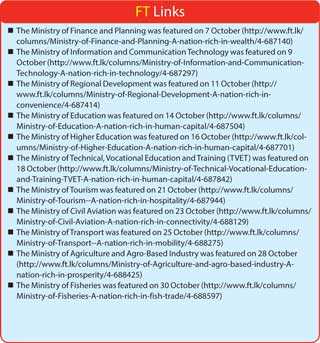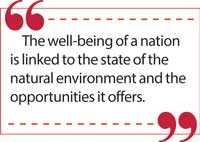Monday Oct 27, 2025
Monday Oct 27, 2025
Friday, 1 November 2019 00:20 - - {{hitsCtrl.values.hits}}
This series is based on business leader Dhammika Perera’s recently revealed ‘Economic Growth Strategy and Action Plan to increase GDP Per Capita from $ 4,000 to $ 12,000’. The document outlines goals and action plans for 23 ministries and today’s column focuses on the Ministry of Environment and Natural Resources
Goals
Ensure a clean, safe and a healthy environment for present and future generations.
Conserve the vitality and diversity of nature.
Build a liveable and endearing Sri Lanka.
Action plan
1. Improve the rank of Sri Lanka in international environmental indices.
2. Encourage citizens to be more conscious of the environment through educational videos and  factbooks on recycling in all three languages.
factbooks on recycling in all three languages.
3. Generate jobs through planting of 200 million trees within 5 years: employ people in each district to plant 100 million trees for re-forestation and 100 million trees for commercial use.
4. Educate children on environmental sensitivity and protection via Care for Earth awareness videos and recycling factbooks.
5. Build breeding centres for endangered species in collaboration with zoos.
6. Improve 26 wildlife parks (of a total extent of 573,376 Ha) and increase the population of local wildlife:
a. Build additional water resources within wildlife parks.
b. Plant trees in deserted areas to preserve the natural habitat.
c. Install solar water pumps to provide drinking water for animals during droughts.
d. Grow nutritious grass varieties.
e. Introduce wildlife into 200 acres of new land close to the exits of the existing parks and ensure availability of adequate resources for their survival.
7. Identify and breed animals that are not harmful to crops.
8. Introduce a platform where the public can geo-tag and send photos of areas where garbage is piled-up and mosquitoes breed. The Sri Lankan Army to initiate a campaign to clean the country within a year.
9. Organise canal clean-ups and identify canals suitable for waterfront attractions, canal cruises, etc.
10. Provide a 10% corporate tax incentive for all buildings with GBI (Green Building Initiative) or LEED (Leadership in Energy and Environmental Design) certification to minimise the carbon footprint.
11. Conduct vulnerability assessment and prepare an adaptation plan related to climate change.
12. Streamline the public transport system with convenient and reliable public transport methods to reduce traffic congestion (Colombo Happy Ride project).
13. Introduce energy-efficient street lighting systems.
14. Construct power stations in every district, which utilise municipal solid waste.
Construction to be carried out through public-private partnerships.
Government to pay tipping fees for these power stations.
Coastal environment protection
15. Coastal management system.
Identify high erosion areas of coastlines and provide solutions to preserve these areas. Obtain detailed topographical maps of the area to determine what structures to construct. 
90% of corals are dead in Sri Lanka, therefore, establish a “Coral Reef Task Force” to preserve and protect the coral reef ecosystems in Hikkaduwa, Kalpitiya, Silavathurai, Pigeon Island in Trincomalee, Kayankerni Marine Sanctuary in Batticaloa and Passikudah.
16. Raise awareness amongst local fishing communities on methods to revive dead coral reefs, e.g. low cost coral restoration methods.
Biodiversity
17. Raise awareness on the importance of biodiversity through domestic focused eco-tourism and related activities:
a. Formulate and implement the national biodiversity Communications, Education and Public Awareness (CEPA) action plan.
b. Raise awareness through citizen science by creating opportunities for members of the public to be involved in biodiversity research.
c. Enhance the website and social media presence of the Ministry of Environment and Natural Resources and other biodiversity-related agencies.
18. Increase the number of youth participating in nature-based activities:
a. Strengthen environmental training for teachers, administrators and managers across all levels of public education, from pre-school to higher learning institutions.
b. Support and strengthen co-curricular school activities, including nature clubs, green camps and recreational sports, with a focus on outdoor learning in nature.
c. Develop or adopt standardised modules for nature camps to enable such camps to be replicated throughout the country.
d. Enable youth groups to carry out biodiversity conservation projects and internships with suitable organisations.
Flood management
19. Conduct continuous river and river-mouth management, seasonal dredging and filling during the monsoon seasons to prevent flooding.
20. Appoint the engineers of the Sri Lankan Navy as river mouth management officials to mitigate floods.
Disaster management
21. Conduct a National Disaster Risk Profile study and identify potential disasters, disaster-prone areas and degree of severity.
22. Maintain a database of manmade and natural landslide-prone areas and continuously monitor them to understand which regions are at a higher risk.
Drought management
23. Conduct a drought risk assessment to understand existing and potential risks and hazards.
24. Increase food access and protect rural livelihoods, through cash-for-work and emergency livelihood packages for farmers, pastoralists, and coastal communities.
25. Encourage adoption of water-saving technologies, such as sprinkler and drip irrigation systems, through the provision of 50% subsidy to the farmers on the purchase of these systems.
26. Create storage and enable inter-basin transfer of water from surplus to deficit regions which could therefore be an option for achieving more equitable distribution and optimal utilization of water resources.
27. Protect livestock assets, through supplementary animal feeding, water trucking, supply of water bladders, and countrywide supportive treatment.
28. Mitigate new shocks, by providing regional stocks of veterinary supplies, river embankment repair, and strengthening local preparation against food-chain threats.
29. Introduce a District Contingency Plan, including planting of alternate crops/crop varieties/better and smarter agronomic practices/other management options appropriate for drought scenarios.
30. Increase regional self-reliance and integrated water management across all levels of Government through tax incentives to construction projects which practise water management systems.
31. Increase recycled water usage by adopting standard recycling regulations.
32. Protect and restore important ecosystems such as degraded streams, waterways, and wetlands.
33. Restore forest health with ecologically sound forest management.
Wildlife parks
34. Solutions for Human-Elephant conflict.
The human-elephant conflict is an issue faced by the majority of those in the Dry zone. On average, the lives of 70 humans and 250 elephants are lost per annum due to the human-elephant conflict. For the past 70 years the attempt to resolve this issue was by fencing lands managed by the Department of Wildlife Conservation. However, the increasing human-elephant conflict only means that this method is unsuccessful. This is because only 30% of the elephant population inhabit land managed by the Department of Wildlife Conservation where as 70% of the elephants population inhabit land managed by the Department of Forest Conservation.
Build fencing around villages prone to human-elephant conflicts (this method has proven to be successful in over 50 villages). Introduce bio fencing and virtual fencing, operating through sensors that warn the presence of intruding elephants to prevent human-elephant conflict, as there have been several instances where elephants have got electrocuted because of electric fencing.
The Sri Lankan Air Force to geo-tag existing electric fences via Google Maps to identify areas with elephants on both sides of the electric fence.
35. Improve channels, tanks, and drinking facilities for animals by obtaining contour plans of the currently existing 26 wildlife parks with a total extent of 573,376 Ha to eliminate the rate of wild animal deaths during the drought season.
36. Ensure availability of rehabilitation centres for injured animals in all 26 wildlife parks.
37. Implement surveillance at wildlife parks to catch trespassing hunters and poachers.
38. Conduct a feedback survey for rangers to express their requirements and needs.
39. Allocate designated routes for off-road experiences.
40. Standardise specific types of vehicles for use in wildlife safari parks.
41. Provide financial assistance for tour guides to buy safari vehicles.
42. Brand safari guides and train them through video tutorials.
43. Promote safari packages to visitors and enable online purchasing of tickets.
44. Establish signature experiences unique to each park and make these central to their marketing.
45. Improve signage and visibility for wildlife parks, on motorways and entry signs.
46. Improve visitor centres with integrated open cafes and dedicated retail spaces.
47. Create a curriculum-based education package together with the Ministry of Education for school children.